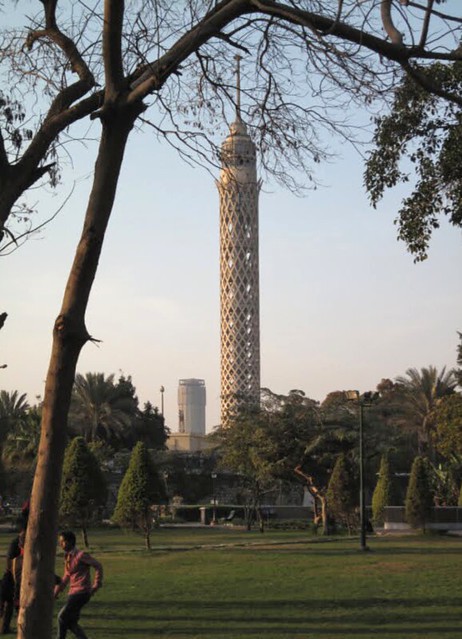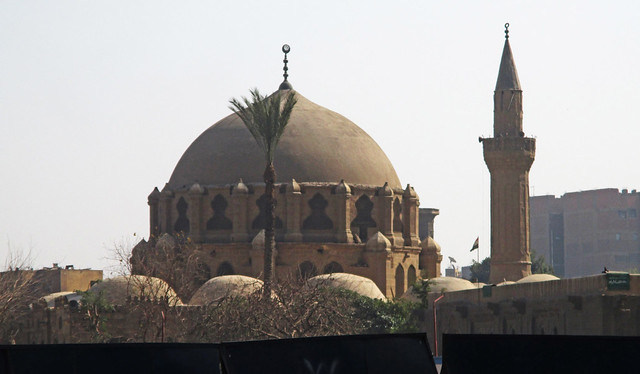... When he was just a child, he was not supposed to go beyond Merza mosque after dark, as all the shops would close and it was too dangerous to walk around. If anyone crossed the mosque “a genie would appear and freeze them and they wouldn’t be able to move,” he tells me.
Lucky for us, it isn’t dark so we aren’t too worried about going past Merza to reach our second destination. El Qadior judge Zayn El-Din Yahya mosque, commonly known as El Mahkama mosque, is famous for missing the top half of its minaret. As legend has it, the minaret was split in half when a huge snake swirled around it.
Not knowing what really happened to the minaret, Salah asks the first man he sees sitting in front of a shop when we walk out of Merza, “Do you know what happened to the Mahkama mosque’s minaret?” The big man’s dark green eyes seem a little worried as they rest on my camera, but Salah introduces himself and reassures him I am doing a story on the area and how it’s changed over the years. Suddenly the man sits up straight. “I have maps.”...After watching the video and reading that article, I came away wondering what will happen to the historic buildings in the district and curious to know more about the Ali Baba Cinema and its fate. And what about the people who called Bulaq home for many generations?
Let's deal with the Ali Baba Cinema first.
In 1946, architect Naoum Shebib invented a process for building a domed roof which he patented and is known as the "Chebib Vault."
The "Voûte Chebib" was a unique method that consisted in the following steps: 1) an earth mould was fashioned in the shape of the desired thin shell, 2) steel rods were positioned within the mould, 3) a thin layer of concrete was poured over the entire structure, embodying the steel rods while taking the shape of the mould and 4) the hardened concrete vault was slowly raised to its final position by using an ingenious system of jacks. In this case, the vault was raised to a height of 12 meters (40 feet).
Shebib went on to greater fame as the architect of the Cairo Tower.

The Ali Baba set the tone for a class of popular cinema showplaces know as "Terzo theaters." The Ali Baba was actually torn down in the summer of 2017, departing before this latest mass leveling.
This article explores the Terzo theater genre and the heyday of Egyptian movies in more detail.
“Since my childhood, I used to go to Ali Baba to enjoy its diverse programme,” Saber Sarhan, an employee of a garments store opposite the now-ruined cinema recalled. “I would see two Arabic and a foreign film for a ticket of three piastres [one pound equals 100 piastres]. But that was in the late 1960s before prices have gone crazy,” the 54-year-old man told Gulf News.Besides providing memories for Cairo cinema fans and architecture students, the Ali Baba became quite an attraction for the gay community in more recent years. I will leave it to the reader and Google to explore the numerous explicit and NSFW sites that describe that role.
As for the historic mosques and a few buildings from the British Colonial period, those will be preserved. You can see some of these on the distant edge of the cleared area.

And the very historic mosque of Sinan Pasha is well beyond the current zone of destruction. We will see more of it in the next post.

As for the long suffering residents of Bulaq, there were many years of discussion before displacement began. The government offered compensation as it purchased the land and that took a number of years. While the compensation may have represented adequate market value, it was not enough to finance a home and lifestyle in the sandy desert suburbs where the government planners would have the residents live. This review of that twenty-six minute film about Bulaq finds the displacement of Bulaq residents to be at the heart of the 2011 revolution:
Although world and Egyptian media have been fixated on the symbolic Tahrir Square, little attention has been directed towards places where many Egyptians converging on the square actually live. Bulaq, only a few hundred meters north of Tahrir Square, is one such neighborhood.
The residents of Bulaq represent the essence of why Egyptians erupted in mass protests last year. This is a community that has suffered for nearly forty years at the hands of the Sadat and Mubarak regimes, which aimed to erase the district from Cairo’s map.One additional view of Bulaq can be found in this three minute music video. Besides serving as an introduction to the modern Egyptian techno-music of youth that can be heard at parties and wedding receptions, the subtitles provide a quick introduction to Bulaq.
The first thing that comes to mind when you hear "Bulaq" is a picture of a ghetto, and all the stereotypes that comes with that.
But, it's not like that. Yeah, maybe it's crowded. But that's the case for any ghetto. But it's not the case that you're scared when you walk into it.
With all of that as background, my next post will take you on a walk through the shops, mini-factories and interesting sights that stand just outside the current Bulaq destruction zone.






No comments:
Post a Comment